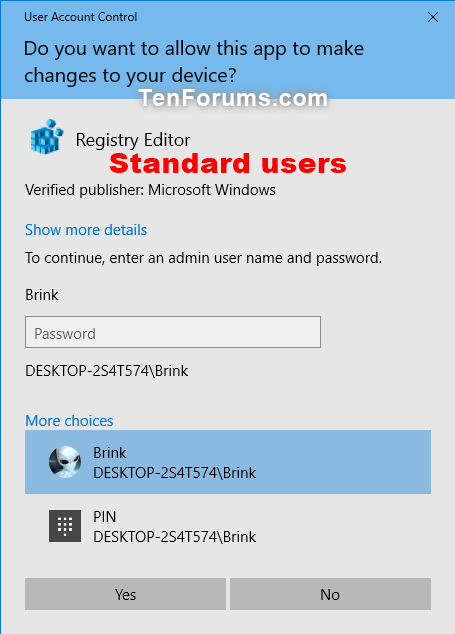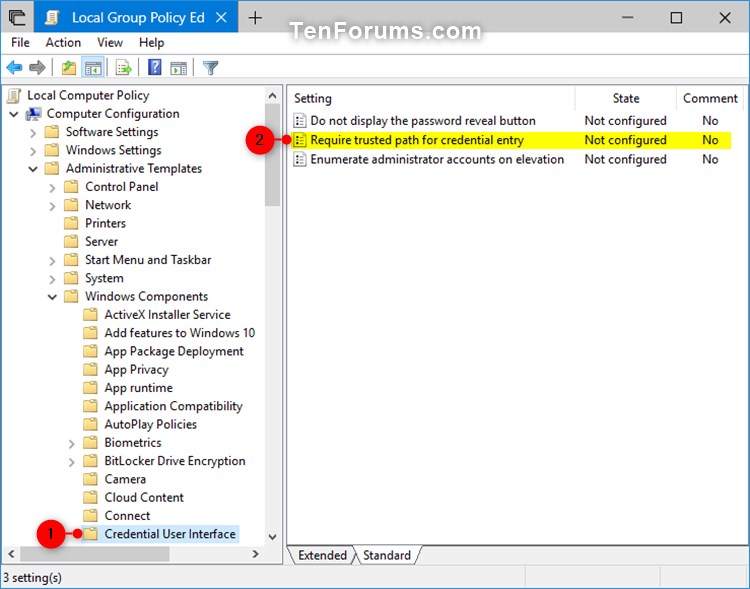How to Enable or Disable Ctrl+Alt+Delete Secure Desktop for UAC prompt in Windows
When User Account Control (UAC) is enabled, Windows prompts for consent or prompts for credentials of a valid local administrator account before starting a program or task that requires a full administrator access token. This prompt ensures that no malicious software can be silently installed or run.
With the Always notify or Default UAC setting enabled, your desktop will be switched to the dimmed secure desktop when you get an elevation request by the User Account Control (UAC) prompt.
A user that is a member of the Administrators group can log on, browse the Web, and read e-mail while using a standard user access token. When the administrator needs to perform a task that requires the administrator access token, Windows 10 automatically prompts the user for Y/N approval. This prompt is called an elevation prompt for UAC consent prompt.
The user experience for standard users is different from that of administrators in Admin Approval Mode. The recommended and more secure method of running Windows 10 is to make your primary user account a standard user account. Running as a standard user helps to maximize security for a managed environment. With the built-in UAC elevation component, standard users can easily perform an administrative task by entering valid credentials for a local administrator account. The default, built-in UAC elevation component for standard users is the UAC credential prompt.
See also: How User Account Control works (Windows 10) | Microsoft Docs
If you like, you can enable a policy that requires users to press Ctrl+Alt+Delete when prompted by UAC to provide consent (administrators) or credentials (standard users) on the Secure Desktop by means of the trusted path mechanism for better security. This can prevent a Trojan horse or other types of malicious code from stealing the userís Windows credentials.
This tutorial will show you how to enable or disable requiring Ctrl+Alt+Delete Secure Desktop (aka: authentic Windows sign-in screen) for User Account Control (UAC) prompt for all users in Windows 7, Windows 8, or Windows 10.
You must be signed in as an administrator to enable or disable requiring Ctrl+Alt+Delete Secure Desktop for UAC prompt.
- Option One: Enable or Disable Ctrl+Alt+Delete Secure Desktop for UAC prompt in Local Group Policy Editor
- Option Two: Enable or Disable Ctrl+Alt+Delete Secure Desktop for UAC prompt using a REG file
EXAMPLE: Ctrl+Alt+Delete Secure Desktop for UAC prompt

The Local Group Policy Editor is only available in the Windows 7/8/10 Pro, Windows 7/8/10 Enterprise, and Windows 10 Education editions.
All editions can use Option Two below.
1. Open the Local Group Policy Editor.
2. In the left pane of Local Group Policy Editor, navigate to the location below. (see screenshot below)
Computer Configuration\Administrative Templates\Windows Components\Credential User Interface
3. In the right pane of Credential User Interface in Local Group Policy Editor, double click/tap on the Require trusted path for credential entry policy to edit it. (see screenshot above)
4. Do step 5 (disable) or step 6 (enable) below for what you would like to do.
A) Select (dot) Not Configured or Disabled, click/tap on OK, and go to step 7 below. (see screenshot below)
Not Configured is the default setting.
7. When finished, close the Local Group Policy Editor if you like.
The downloadable .reg files below will add and modify the DWORD value in the registry key below.
HKEY_LOCAL_MACHINE\SOFTWARE\Microsoft\Windows\CurrentVersion\Policies\CredUI
EnableSecureCredentialPrompting DWORD
(delete) = Disable
1 = Enable
1. Do step 2 (enable) or step 3 (disable) below for what you would like to do.
A) Click/tap on the Download button below to download the file below, and go to step 4 below.
Enable_Ctrl+Alt+Del_Secure_Desktop_for_UAC_prompt.reg
Download
This is the default setting.
A) Click/tap on the Download button below to download the file below, and go to step 4 below.
Disable_Ctrl+Alt+Del_Secure_Desktop_for_UAC_prompt.reg
Download
4. Save the .reg file to your desktop.
5. Double click/tap on the downloaded .reg file to merge it.
6. When prompted, click/tap on Run, Yes (UAC), Yes, and OK to approve the merge.
7. You can now delete the downloaded .reg file if you like.
That's it,
Shawn
Related Tutorials
- How to Enable or Disable User Account Control (UAC) in Windows
- How to Enable or Disable User Account Control (UAC) prompt for Built-in Administrator in Windows
- How to Change User Account Control (UAC) Settings in Windows 10
- How to Change User Account Control (UAC) prompt Behavior for Administrators in Windows
- How to Change User Account Control (UAC) prompt Behavior for Standard Users in Windows
- How to Hide or Show Administrators in UAC prompt for Standard Users in Windows
- How to Enable or Disable Dimmed Secure Desktop for UAC prompt in Windows
- How to Enable or Disable Secure Sign-in with Ctrl+Alt+Delete in Windows 10
Enable Ctrl+Alt+Delete Secure Desktop for UAC prompt in Windows

Enable Ctrl+Alt+Delete Secure Desktop for UAC prompt in Windows
How to Enable or Disable Ctrl+Alt+Delete Secure Desktop for UAC prompt in WindowsPublished by Shawn BrinkCategory: User Accounts
31 Dec 2018
Tutorial Categories


Related Discussions







